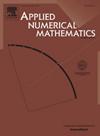双谐波非线性薛定谔方程时间分割正弦伪谱法的最佳误差边界
IF 2.2
2区 数学
Q1 MATHEMATICS, APPLIED
引用次数: 0
摘要
我们提出了双谐波非线性薛定谔方程(BNLS)的时间分割正弦伪谱(TSSP)方法,并建立了其最佳误差边界。在所提出的 TSSP 方法中,我们采用正弦伪谱法进行空间离散化,采用二阶斯特朗分裂法进行时间离散化。所提出的 TSSP 方法是显式和结构保留的,如时间对称、质量守恒和在离散化水平上保持原始 BNLS 的离散关系。假设一维 BNLS 的解属于 Hm,m≥9,我们证明了所提出的 TSSP 方法在 L2 准则和 H1 准则下的误差边界分别为 O(τ2+hm)和 O(τ2+hm-1),时间步长为 τ,网格大小为 h。对于 d=1,2,3的一般维数情况,假设精确解在 m≥10 的 Hm 中,误差边界在 L2 和 H2 规范下分别为 O(τ2+hm) 和 O(τ2+hm-2)。证明是基于局部截断误差的 Lie-commutator 约束、离散 Gronwall 不等式、能量法和数值解的 H1 或 H2 约束,这意味着数值解的 L∞ 约束。最后,报告了大量数值结果,以证实我们的最佳误差约束,并展示了解的丰富现象,包括高频波和孤子碰撞在空间的快速弥散。本文章由计算机程序翻译,如有差异,请以英文原文为准。
Optimal error bounds of the time-splitting sine-pseudospectral method for the biharmonic nonlinear Schrödinger equation
We propose a time-splitting sine-pseudospectral (TSSP) method for the biharmonic nonlinear Schrödinger equation (BNLS) and establish its optimal error bounds. In the proposed TSSP method, we adopt the sine-pseudospectral method for spatial discretization and the second-order Strang splitting for temporal discretization. The proposed TSSP method is explicit and structure-preserving, such as time symmetric, mass conservation and maintaining the dispersion relation of the original BNLS in the discretized level. Under the assumption that the solution of the one dimensional BNLS belongs to with , we prove error bounds at and in norm and norm respectively, for the proposed TSSP method, with τ time step and h mesh size. For general dimensional cases with , the error bounds are at and in and norm under the assumption that the exact solution is in with . The proof is based on the bound of the Lie-commutator for the local truncation error, discrete Gronwall inequality, energy method and the - or -bound of the numerical solution which implies the -bound of the numerical solution. Finally, extensive numerical results are reported to confirm our optimal error bounds and to demonstrate rich phenomena of the solutions including rapidly dispersion in space of high frequency waves and soliton collisions.
求助全文
通过发布文献求助,成功后即可免费获取论文全文。
去求助
来源期刊

Applied Numerical Mathematics
数学-应用数学
CiteScore
5.60
自引率
7.10%
发文量
225
审稿时长
7.2 months
期刊介绍:
The purpose of the journal is to provide a forum for the publication of high quality research and tutorial papers in computational mathematics. In addition to the traditional issues and problems in numerical analysis, the journal also publishes papers describing relevant applications in such fields as physics, fluid dynamics, engineering and other branches of applied science with a computational mathematics component. The journal strives to be flexible in the type of papers it publishes and their format. Equally desirable are:
(i) Full papers, which should be complete and relatively self-contained original contributions with an introduction that can be understood by the broad computational mathematics community. Both rigorous and heuristic styles are acceptable. Of particular interest are papers about new areas of research, in which other than strictly mathematical arguments may be important in establishing a basis for further developments.
(ii) Tutorial review papers, covering some of the important issues in Numerical Mathematics, Scientific Computing and their Applications. The journal will occasionally publish contributions which are larger than the usual format for regular papers.
(iii) Short notes, which present specific new results and techniques in a brief communication.
 求助内容:
求助内容: 应助结果提醒方式:
应助结果提醒方式:


